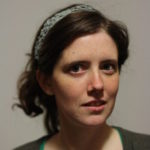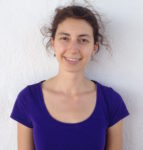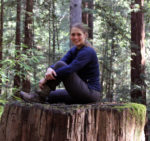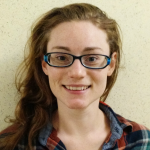 Laura Alexander Laura Alexander
Integrative Biology |
Laura worked with the Getz lab using niche modeling to predict the range of Ebola using a dataset including plausible but unconfirmed outbreaks in humans and animals. |
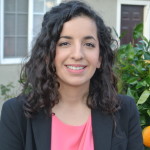 Jenna Baughman Jenna Baughman
Integrative Biology |
The Florida Everglades have been described as having regular or periodic landscape patterning, with characteristic bands of sawgrass-dominated ridges and slow-flowing sloughs. Yet, the processes that develop and maintain the Everglades are not well understood. Quantifying the spatial characteristics of these landscape patterns can provide insight into the processes as well as provide metrics for model validation. Using Matlab, I used spatial spectral analyses to compare landscape patterns and frequencies represented in simulated ridges and sloughs from the RASCAL Everglades model to observations from arial imagery. Worked with Laurel Larsen in Geography. |
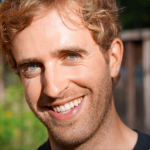 Ian Bolliger Ian Bolliger
Energy and Resources Group |
Solar Radiation Management (SRM) has been proposed as a potential geoengineering strategy to offset rising global temperatures. This approach would involve the injection of sulfate aerosols into the stratosphere, which would reflect sunlight and cool the Earth. While the resulting effect on global temperature is relatively understood, secondary local impacts on climate and weather patterns are largely unknown, though several regional impacts have been hypothesized. Regional climate changes could have profound impacts on agriculture, a spatially heterogeneous sector that is strongly tied to precipitation, temperature, and sunlight. In the study I participated in for the RET, we attempted to estimate the impact of proposed SRM scenarios on the yields of several staple crops. To do this, we first estimated the impact of a set of climate variables on yields, using large volcanic eruptions, which also spew sulfur into the stratosphere, as natural analogues. Next, we used the results of climate models in which SRM was and was not applied. This allowed us to identify the location-specific changes in the relevant climate variables that were due to SRM implementation. Applying the relationships identified in the first step to the model results from the second, we were able to estimate a yield impact of SRM. My particular work on this project involved the development of an analysis plan for the climate model data, model selection and data acquisition, and initial preprocessing of the model output. |
 Hal Gordon Hal Gordon
Agriculture and Resource Economics |
Hal worked with Felipe Castro in the Energy and Resources Group on consumer electricity demand. |
 Andrew Hultgren Andrew Hultgren
Agriculture and Resource Economics |
Andy worked with Duncan Calloway from the Energy Resources Group on the effect of the load of charging many electric vehicles on the energy grid. |
 Yang Ju Yang Ju
Landscape Architecture and Environmental Planning |
Yang worked with a graduate student in urban planning. |
 Matthew Kling Matthew Kling
Integrative Biology |
I worked in Sol Hsiang’s lab at the Goldman School of Public Policy on a project collaborating with his PhD student Jon Kadish. The project was aimed at estimating the impacts of climate changes on electricity use in China. We combined historic data on localized electricity use, climate variation, changing appliance ownership, and population in a set of regression models, leveraging temperature variation across years and across Chinese provinces to estimate the energy impacts of changes in the frequency of hot and cold days. We were able to quantify how temperature anomalies have affected air conditioner purchases and electricity use in recent decades, helping to inform predictions about the impacts of future climate change on energy use. |
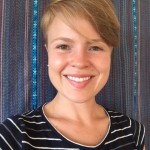 Kate Pennington Kate Pennington
Agriculture and Resource Economics |
Kate spent the summer building a data set that codes changes in vehicle emissions regulation in India from 1987-2016 at the district level. She plans to use the data to evaluate the impact of emissions policy on particulate matter concentrations, estimated emissions, local precipitation, crop yields, and health. Kate worked with John Chiang in Geography. |
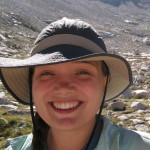 Dana Seidel Dana Seidel
Environmental Science, Policy and Management |
For my RET project, I partnered with Dr. Gabriel Lenz, a professor in the Political Science department at UC Berkeley. The objective of my project was to explore the relationship between energy prices and the incumbent party’s vote share in presidential elections from 1970-2012. Energy price data was gathered for each state and year from the US Energy Information Administration and data on US voter participation by county and state were compiled by Dr. Lenz. Although I had previous experience analyzing large data sets of the course of my research, being a natural scientist in training, this was a new opportunity for me to work with data regarding human behavior and the first time I had assessed something so historical in nature. Over the course of this project, I gained a lot of experience cleaning and organizing multidimensional data from different sources in R. Given the complexity of the available data, I became very practiced in tools for exploratory analyses and for pattern visualization in the data as we explored early hypotheses. Notably, I learned a lot about how political scientists approach regression models and how this differs from the approaches I was more familiar with from the life sciences. The project offered me a unique opportunity to gain experience with data and methods in political science and to sharpen my general data analysis, visualization, and communication skills. |
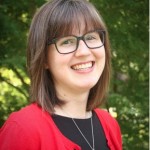 Sara Stoudt Sara Stoudt
Statistics |
Understanding the dynamics of water quality in the San Francisco Estuary: a Generalized Additive Model approach
Long-term time series of water quality measurements spanning multiple locations in the San Francisco Estuary are available. The challenge is to leverage this data to learn how nutrient concentrations vary across space and time in the Delta, what the major drivers of this variability are, and if any mechanistic insights can be gained by exploring the relationships between various variables collected. Working with the San Francisco Estuary Institute (SFEI), I built and visualized several different models to provide insight into the complicated system of the Delta. Generalized Additive Models, if built in a nested way, can be easily visualized to see how each variable contributes to the overall variability in the quantity of interest. By creating a web application to easily explore and visualize the results from different models, scientists at SFEI can better identify potential drivers of change in the Delta and form hypotheses that can be tested with further analyses. |
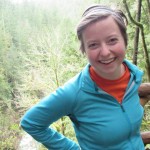 Carmen Tubbesing Carmen Tubbesing
Environmental Science, Policy and Management |
The epic drought that hit California between 2012 and 2016 has had devastating effects on our state’s forests, killing over 100 million trees. The state is scrambling to find ways to remove the dead trees left in the drought’s wake in order to reduce fire and safety hazards. However, only a small fraction of the dead trees could be processed by California’s few lumber mills and biomass energy facilities. Converting the dead tree biomass to energy is particularly difficult given the high cost of transporting dead trees to far-off biomass facilities and low energy prices in return. One possible solution would be to gasify and burn the biomass on-site with small, portable biomass gasifier generators, such as those created by All Power Labs here in Berkeley. To assess the feasibility of such a solution, Carmen worked with Jose Lara in the Energy and Resources Group and other researchers to model the costs and revenue that would result from wide deployment of biomass gasifiers. Carmen’s contribution to the project included calculating spatially-explicit estimates of the amounts of biomass that have resulted from drought-induced tree mortality. She used a combination of aerial assessments of numbers of dead trees in polygons throughout the state and a rasterized model of live biomass and forest characteristics at fine resolution. Carmen’s estimates, along with information on distance to roads and substations, topography, and other factors, allowed for a detailed analysis of where gasifiers could be economically deployed. |
 Valeri Vasquez Valeri Vasquez
Energy and Resources Group |
I contributed to the work of the Climate Impact Lab, an interdisciplinary team of data scientists, climate experts, and economists, by spending my RET in the Global Policy Laboratory at the Goldman School of Public Policy. The goal of the Climate Impact Lab’s broader project is to conduct a meta-analysis of the existing climate impacts literature in order to develop an empirical basis for the Social Cost of Carbon (SCC). My particular focus was on estimating the relationship between climate change – namely, temperature and precipitation shifts – and human conflict. |
 Jacob Bukoski
Jacob Bukoski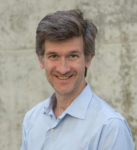 Nathaniel Decker
Nathaniel Decker Gabriel Englander
Gabriel Englander Frank Errickson
Frank Errickson Scott Kaplan
Scott Kaplan

